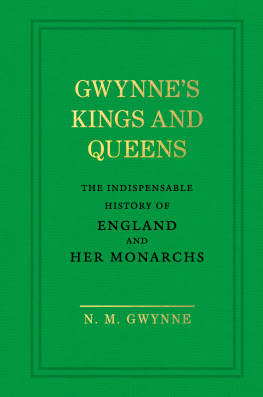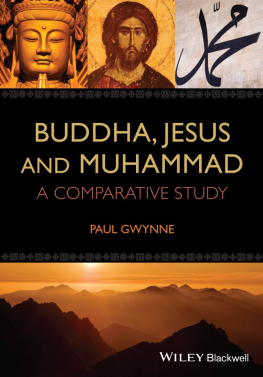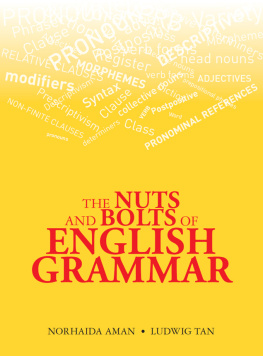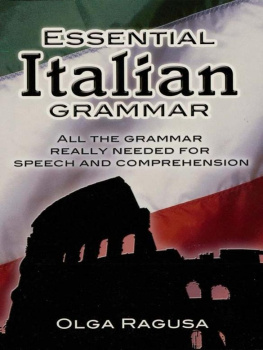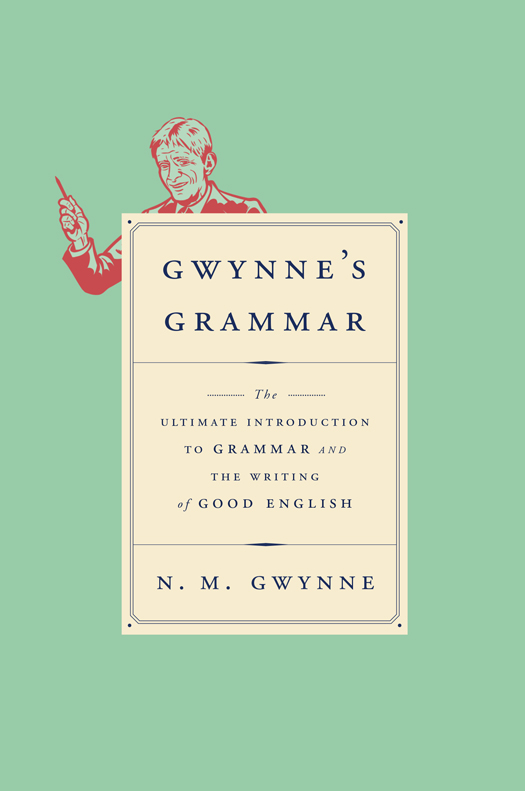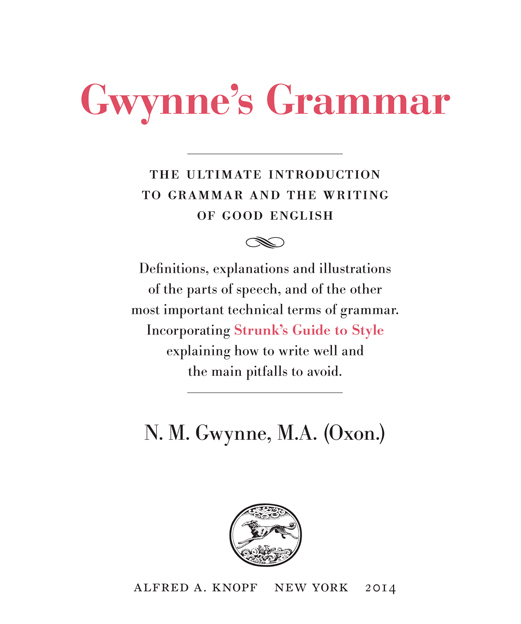THIS IS A BORZOI BOOK
PUBLISHED BY ALFRED A. KNOPF
Copyright 2013, 2014 by N. M. Gwynne
All rights reserved. Published in the United States by Alfred A. Knopf, a division of Random House LLC, New York, and in Canada by Random House of Canada Limited, Toronto, Penguin Random House Companies.
www.aaknopf.com
Knopf, Borzoi Books, and the colophon are registered trademarks of Random House LLC.
Originally published in slightly different form by Ebury Press, an imprint of Ebury Publishing, a Random House Group company, London, in 2013.
Library of Congress Cataloging-in-Publication Data
Gwynne, N. M.
Gwynnes grammar : the ultimate introduction to grammar and the writing of good English / N.M. Gwynne. First American Edition.
pages cm
ISBN 978-0-385-35293-2 (hardback)
ISBN 978-0-385-35294-9 (eBook)
1. English languageGrammar. 2. English languagePunctuation. 3. English languageRhetoric.
I. Title. II. Title: Grammar. III. Title: The ultimate introduction to grammar and the writing of good English.
PE 1106. G 89 2014
425dc23 2014019245
eBooks ISBN:9780385352949
Jacket design by Oliver Munday
v3.1_r1
To those pupils of mine in various parts of the world, of ages ranging from two years old right up to elderly adulthood, and in many cases to their parents and even grandparents as well, all of whom between them are primarily responsible for this bookor, rather, bookscoming into existence
Contents
Preface
M uch more than is customary, this Preface is intrinsic to a proper understanding of the rest of this book and to how to make the best possible use of it. The reader is urged to read it with some care.
I can say with complete safety that what you have in your hands is a thoroughly practical little book. It owes that feature to a number of remarkable circumstances.
The first is the manner in which it came into existence. For many years now, I have been teaching, at one time or another, most of the academic subjects but principally Latin. Thanks to the Internet, I have been doing this largely while sitting at homeremarkably, within seconds of a class starting, it is as though we are in the same classroom together.
My pupils ages have ranged from two years old to over seventy. Of the younger ones, some have been home-schooled, and some I have given classes to just before or after school, in parts of the world ranging from India in one direction, through Europe, to the west coast of the United States in the other. I have even been employed by Selfridges (one of the two most famous department stores in London, Harrods being the other) to give a series of once-a-week lectures on English grammar, most of them two hours long, to all comers in the stores Ultralounge.
In every case, I have been having to tackle English grammar with my pupils, either because it has been largely forgotten by my older pupils or because it has been ignored, most often completely, in the schools that my younger pupils attend or have attended. I have had to do this simply in order to make it possible to teach the other subjects satisfactorily.
Enter now the publisher of the original edition of this book, Mr. Tom Hodgkinson, the father in one of my families of pupils. From the time that I started teaching his children after school hours, he would often sit in on the classes, as I very much encourage parents, and even grandparents and other family members, to do when they can. Himself an experienced journalist, he was endlessly interested by the English grammar I was teaching his childrenso much so that he eventually came up with the suggestion that I should put together what I had been teaching into a small book which he would publish, and which we could be confident would be useful and helpful. He even chose its two-word title.
In spite of very little advertising other than by word of mouth, the first edition exhausted its print run with encouraging speed, as did two subsequent editions, each of them incorporating additional material arising from questions raised and comments made by my pupils, and by others of all ages who have read this book, including schoolteachers of the highest seniority.
The next development was that Mr. Jake Lingwood of Ebury Press, of the Random House Group, noticed the book in a catalogue, and approached Mr. Hodgkinson and me, with the suggestion that a well-designed cover and the sort of promotion that a large publishing company could offer might bring the book to a much wider readership. The result of the new partnership that emerged was, to me at least, astonishing. At once the Ebury edition reached the top ten hardback best sellers in England, and even number one in some lists, and there it stayed for about five months.
Now comes this books introduction to America, courtesy of Alfred A. Knopf, and it is safe to say that what you are now reading is tried and tested (and in several countries) as few books have the opportunity to be. It is, moreover, expressly designed to fill a need specific to the present day and, beyond doubt, to the foreseeable future: a need which my experience has brought forcibly and repeatedly to my attention. This is the need to explain and show exactly how grammar in particular and writing in general should be learnt and taught, rather than merely what should be learnt and taught. More on this later in this Preface and also elsewhere in this book.
What is more, I can also safely claim that the present edition is even further improved. In the first place, I have been able to take advantage of suggestions andwhisper it!even corrections offered by readers of the British edition who have been kind enough to contact me with them. In the second place, two chapters have been added. One of them is of considerable importance in my opinion. It is on how to compose the real verse of which genuine poetry has traditionally been held to consist. This skill, once taught to schoolchildren and necessary for even the most elementary appreciation of poetry, let alone for its composition, has been for so long abandoned as to be all but lost; and I rejoice that this book can make a contribution to restoring something that is almost unimaginably worthwhile.
When, near the beginning of this books life in England, the time came for the second edition, there was a problem with the whole concept of a book such as this that it was well worth trying to solve. This was simply that even diligent mastery of the books contents would still leave many readers of it somewhat up in the air as to what they could achieve in the way of good writing.
Acquiring an effortless command of grammar, although normally the indispensable foundation of writing that is competent or better, is only part of the struggle in the process of learning to write well consistently. Once that technical side is learnt, what then needs careful study is how to apply it in order to produce whatever effect one wishes to at any time. That is to say: how to make ones writing crystal-clear, or attractive and enjoyable, or persuasive, or compelling, or any or all of those. That is further to say: how to develop a writing style capable of suiting any useful purpose.
Like grammar, style is fundamentally a science, just as much a science as are any of the physical sciences to which the term is nowadays more commonly applied. Only when this science has been studied and mastered is the student in a position to develop the



